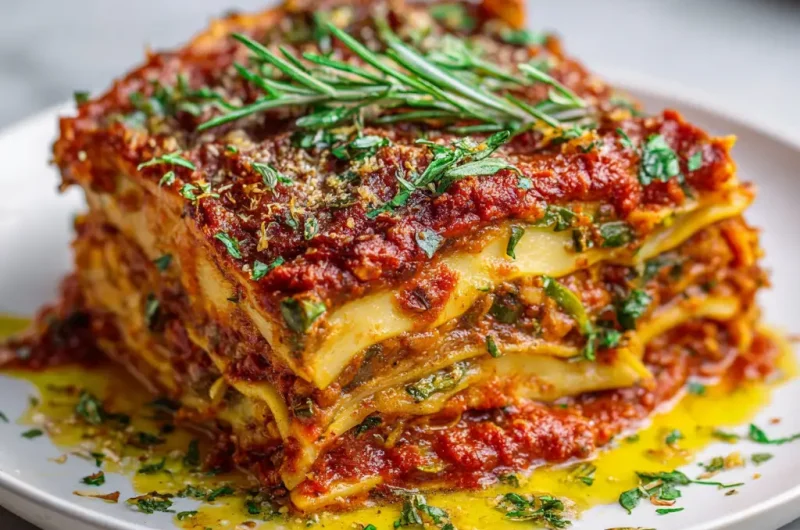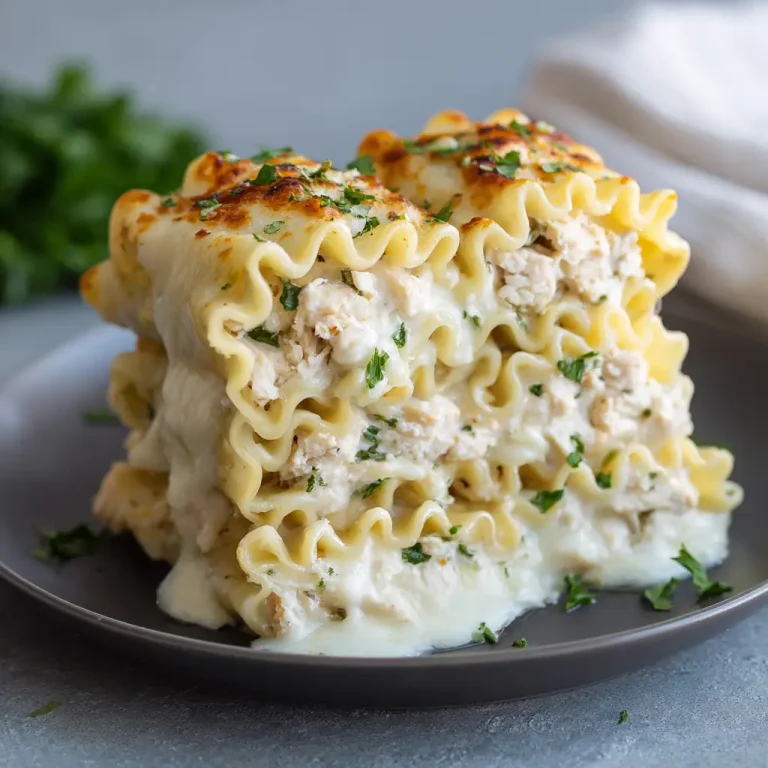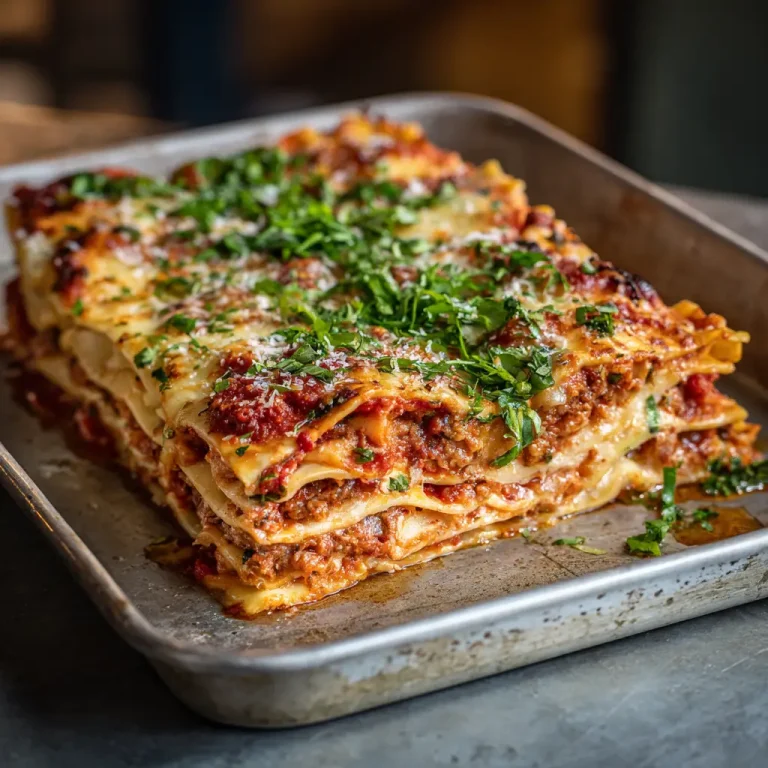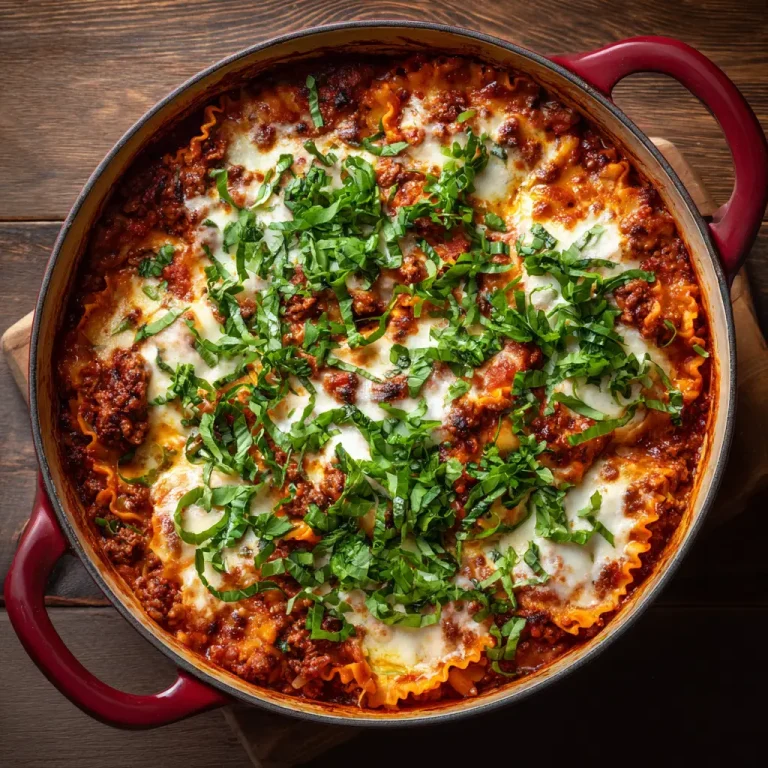Vegan Lasagna Recipe – Easy, Healthy, and Delicious Plant-Based Comfort Food
Introduction
Lasagna has long been a comfort food favorite: layered sheets of pasta, warm sauce, melty cheese, vegetables or meat. Reimagining it in a vegan style opens up a world of creativity and healthful ingredients without sacrificing taste. A vegan lasagna can delight your senses with creamy plant‑based ricotta, hearty tomato sauce, tender vegetables, and satisfying textures. It makes for a beautiful dinner party dish or a cozy weekend meal that feels indulgent yet wholesome.

You do not need to compromise flavor when you eliminate animal products. A well‑crafted vegan lasagna balances moisture, textures, and seasoning so that every bite feels layered, savory, and comforting. This guide walks you through a full version of vegan lasagna, with ingredient suggestions, clear instructions, tips for variation, nutritional insight, and ideas for serving. You will get more confident with each step, and the result can win over even nonvegans. Let us dive in.
Ingredients Needed
Below is a typical list of ingredients you will need. The calorie counts are approximate per full recipe divided by number of servings; adjust based on your exact brands and portion sizes.
| Ingredient | Quantity | Approximate Calories (total for that amount) |
|---|---|---|
| Lasagna noodles (regular or no‑boil, whole wheat or gluten free) | 9‑12 sheets | ~ 300‑400 kcal |
| Tomato sauce or crushed tomatoes | 4 cups (about 1 liter) | ~ 200 kcal |
| Olive oil | 2 tablespoons | ~ 240 kcal |
| Onion, finely chopped | 1 large | ~ 50 kcal |
| Garlic cloves, minced | 3–4 cloves | ~ 15 kcal |
| Mushrooms, chopped | 200 g | ~ 40 kcal |
| Zucchini (or other vegetables like bell pepper, carrot) | 1 medium | ~ 30 kcal |
| Spinach (fresh or thawed frozen) | 200 g | ~ 40 kcal |
| Firm tofu (for ricotta base) | 350 g | ~ 280 kcal |
| Nutritional yeast | 3 tablespoons | ~ 60 kcal |
| Lemon juice | 1 tablespoon | ~ 4 kcal |
| Fresh basil, chopped | handful | negligible |
| Salt and black pepper | to taste | – |
| Dried oregano or Italian herbs | 1 teaspoon | – |
| Plant‑based mozzarella (optional) | 1 cup shredded | ~ 200 kcal |
If you divide into 8 generous servings, each serving may come to ~ 350‑450 kcal, depending on how much cheese substitute you include. (Other vegan lasagna versions fall in similar ranges of 350‑450 kcal per serving)
Step‑by‑Step Cooking Instructions
Here is a clear, easy to follow method. Take your time and enjoy each stage.
1. Preheat and prepare
Preheat your oven to about 190 °C (375 °F). If you use regular lasagna noodles, bring a large pot of salted water to a boil and cook the noodles until they are al dente, slightly underdone (they’ll finish cooking in the oven). Drain, rinse under cold water to stop cooking, and set aside. If using no‑boil noodles, you can skip this step but ensure your sauce is not too watery.
2. Make the vegetable filling
In a large skillet or saucepan, warm the olive oil over medium heat. Add the chopped onion and sauté until translucent, about 4–5 minutes. Add the minced garlic and stir for another minute until fragrant. Add mushrooms, zucchini, and any additional vegetables such as bell pepper or carrot. Cook until the vegetables soften, about 5–7 minutes. Stir in spinach and cook until wilted (if fresh) or heated through (if frozen). Season with salt, pepper, oregano, or Italian herbs.
3. Prepare the vegan ricotta layer
While the vegetables cook, in a blender or food processor combine the firm tofu, nutritional yeast, lemon juice, salt, pepper, and a splash of water or plant milk if needed to smooth it. Blend until creamy but still with some texture (you don’t want it totally liquid). Taste and adjust seasoning. You can fold in chopped basil if you like.
4. Assemble the lasagna
In a baking dish (approx 22×30 cm or similar), spread a thin layer of tomato sauce on the bottom so the noodles do not stick. Then layer as follows:Another classic you shouldn’t miss is Vegetarian Lasagna Recipe _ which complements this dish well.
- A layer of noodles, covering the dish
- A layer of tomato sauce
- A layer of half the vegetable filling
- A layer of half the tofu ricotta
- Repeat: noodles, sauce, remaining vegetables, remaining ricotta
- Finish with a final layer of noodles and a generous top layer of tomato sauce
- Optionally sprinkle the plant‑based mozzarella substitute on top
Cover the dish with aluminum foil (or a lid) for the first baking stage.
5. Bake
Place the lasagna in the preheated oven and bake covered for about 25–30 minutes. Then remove the foil, and bake an additional 10–15 minutes or until the top is bubbling and golden. If you like a crispier top, you can broil for a minute or two at high heat—but watch carefully so it does not burn.
6. Rest and slice
Let the lasagna rest off heat for at least 10 minutes so it sets and is easier to slice. Then cut into portions and serve.

Tips for Customizing the Recipe
- Use gluten‑free noodles (e.g. rice, buckwheat, lentil pasta) if you need the dish free of gluten.
- Swap or add vegetables: eggplant, roasted red peppers, sweet potato, kale, or butternut squash all work beautifully.
- If you want extra protein, mix cooked lentils or cooked red beans into the vegetable layer.
- For a richer “cheese” feel, you may add soaked cashews into the tofu ricotta blend or use cashew ricotta entirely.
- Use low‑sodium tomato sauce or make your own crushed tomatoes so you control salt content.
- Add layers of fresh herbs like basil or spinach leaves between layers.
- For a smokier flavor, incorporate a little smoked paprika or liquid smoke into the tofu ricotta.
- If you prefer a lighter version, reduce the amount of olive oil and skip the vegan cheese topping.
- You may prepare this ahead: assemble the lasagna (without baking) and refrigerate overnight; then bake when ready.
- Leftovers store well and often taste even better the next day as flavors meld.
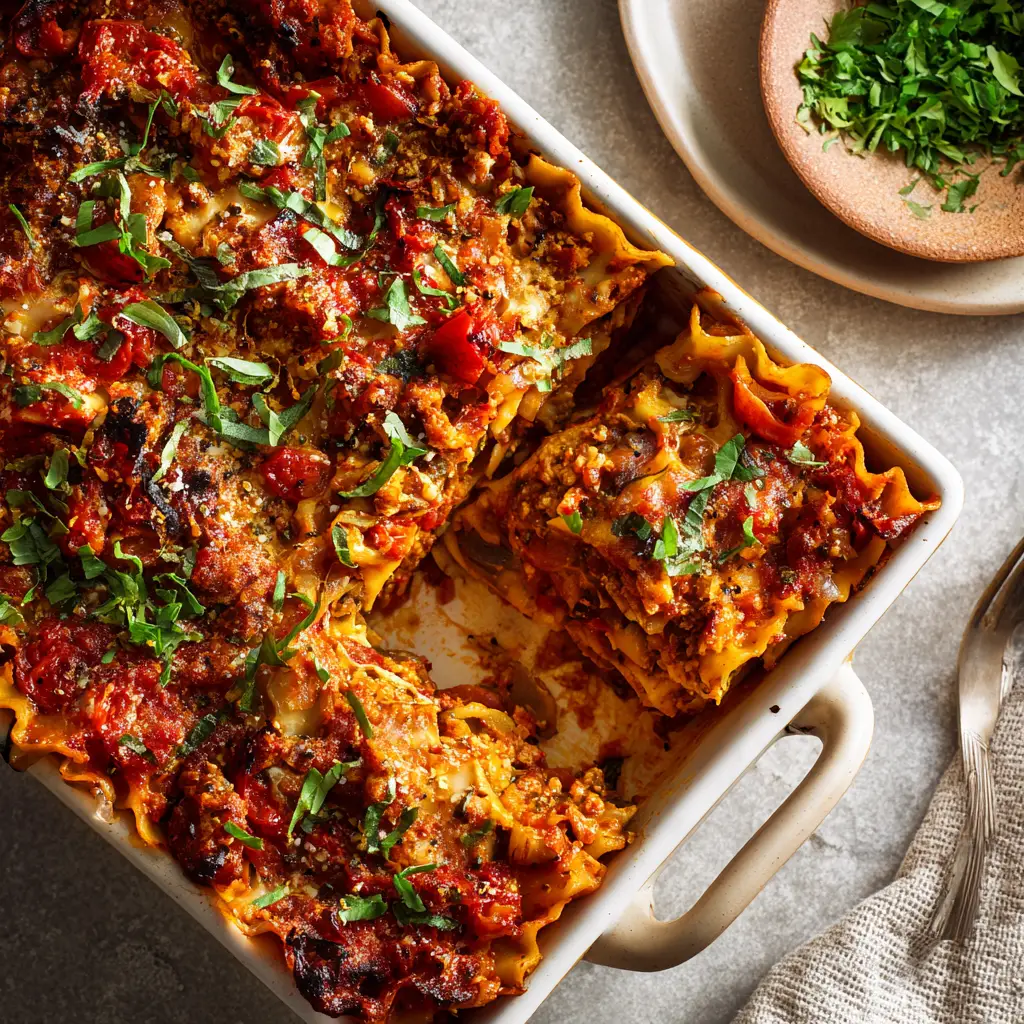
Nutritional Information
Here is a rough nutritional breakdown per serving (assuming 8 servings):
| Nutrient | Approximate Amount per Serving |
|---|---|
| Calories | 350‑450 kcal |
| Protein | 12‑18 g |
| Carbohydrates | 40‑50 g |
| Dietary Fiber | 6‑10 g |
| Fat | 10‑18 g (mostly unsaturated) |
| Saturated Fat | 1‑3 g |
| Sodium | Depends heavily on sauce, but plan moderate (400‑700 mg) |
| Iron, calcium, potassium | Moderate amounts, depending on vegetable and tofu content |
Some versions of vegan lasagna report ~ 240 kcal per serving (lighterwhile others with richer components may reach ~ 450 kcal per portion Your actual values depend on brands and ingredients chosen.
Because plant‑based ingredients tend to come with fiber, phytonutrients, and less saturated fat, this dish can be more healthful than a traditional lasagna with heavy cream and cheese.
Serving Suggestions
A warm slice of vegan lasagna pairs beautifully with:
- A crisp green salad tossed with lemon vinaigrette
- Garlic bread (vegan butter or olive oil brushed)
- Steamed or roasted broccoli or asparagus
- A glass of dairy‑free white wine or a light herbal iced tea
- Finely chopped fresh basil or parsley sprinkled on top
- Red pepper flakes or drizzle of chili oil for heat
- A side of marinated olives or pickles for contrast
Serve with a scoop of fresh salad or steamed greens to balance the richness of the lasagna. It can be a full main course or part of a larger spread when entertaining.
Vegan Lasagna Recipe – Easy, Healthy, and Delicious Plant-Based Comfort Food
Course: Blog8
servings25
minutes45
minutes400
kcalIngredients
For the Vegetable Sauce Layer:
2 tablespoons olive oil
1 large onion, finely chopped
3–4 garlic cloves, minced
200 g mushrooms, chopped
1 zucchini, diced
200 g spinach (fresh or thawed from frozen)
4 cups tomato sauce or crushed tomatoes
1 teaspoon dried oregano or Italian seasoning
Salt and black pepper, to taste
Directions
- Cook or Prepare Lasagna Noodles:
- If using regular noodles, boil them until al dente. Drain and rinse under cold water. If using no-boil noodles, skip this step.
- Prepare the Vegetable Filling:
- Heat olive oil in a large pan. Sauté onion until soft (about 5 minutes). Add garlic and stir for 1 minute. Add mushrooms and zucchini, cook until soft. Stir in spinach and cook until wilted. Season with salt, pepper, and herbs. Pour in the tomato sauce and let simmer for 5–10 minutes.
- Make Vegan Ricotta:
- In a blender or food processor, combine tofu, nutritional yeast, lemon juice, salt, and pepper. Blend until smooth but thick. Add water or plant milk if needed for blending. Fold in fresh basil if using.
Recipe Video
Notes
- You can prepare this lasagna a day in advance and store it in the fridge before baking. It also freezes well. To make it gluten-free, use gluten-free lasagna noodles and check all other labels. Add cooked lentils or beans between layers for extra protein. Let it rest after baking so it slices neatly and holds its shape.
Frequently Asked Questions (FAQs)
Can I make the lasagna ahead and freeze it?
Yes. Assemble the lasagna without baking or bake it partly, cool it, and wrap tightly in foil or freezer safe wrap. Freeze for up to 2–3 months. When ready to serve, thaw in refrigerator overnight, then bake until hot through (you may need extra time).
What to do if my lasagna turns out watery?
If the sauce is too thin, use less extra liquid, or simmer the sauce longer to reduce. Also ensure tofu ricotta is not too watery (drain tofu well). After baking, let it rest for 10‑15 minutes so excess moisture is absorbed.
Can I skip the tofu and use only vegetables?
Yes. You can make a fully veggie lasagna with layers of eggplant, zucchini, spinach, mushrooms, and sauce. It will be lighter and more like a vegetable bake, though you may lose the “cheesy cream” layer. You might supplement with cashew cream or blended nuts for creaminess.
Is it necessary to use nutritional yeast?
Nutritional yeast adds a savory, cheesy flavor and B vitamins. If you omit it, increase herbs or use vegan cheese alternatives to enhance flavor. The dish will still work, though the umami depth may be milder.
How do I make it gluten free?
Simply use gluten‑free lasagna sheets or gluten‑free pasta alternatives. Ensure any sauces or substitutes (like vegan cheese) are gluten free as well.
Conclusion
Vegan lasagna invites both creativity and satisfaction. By layering tender noodles, rich tomato sauce, vegetables, and a creamy plant ricotta, you can create a dish that delights both vegans and nonvegans alike. The process is straightforward, the ingredients flexible, and the result deeply satisfying. Try customizing with your favorite vegetables or alternative layers, serve it with fresh salad, and savor how comfort food can be both nourishing and kind to the planet. Happy cooking—and may every warm slice bring you joy at the table.

